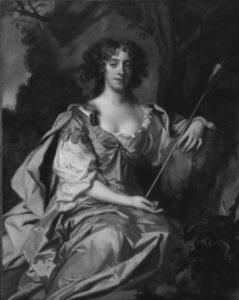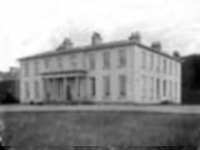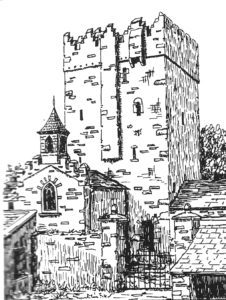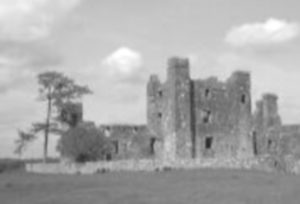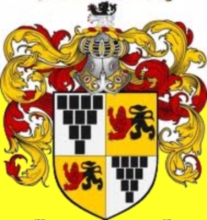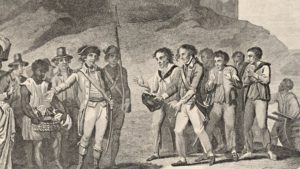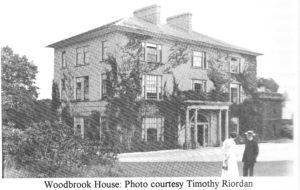Braddell of Wexford, Wicklow and Carlow
The Braddell connection with Wexford, Wicklow and Carlow began as far back as the late 17th century when it is recorded that one James Braddell signed his will on Feb. 10th 1714 as ‘Braddyll’. Obviously he had been in the area for a number of years prior to his death. In the same article it was stated that the first Braddells came to Ireland with Cromwell but there is no mention of Braddells in Prendergast’ s book ‘Cromwellian Settlement in Ireland’. In any event they certainly got no lands in Wexford (or anywhere else) at that time. The lands latterly occupied by the Braddells, were noted, in the Down Survey as being owned by Lord Baltimore, (who was in fact regranted the lands) and the Wentworths (Earls of Fitzwilliam).
Click HERE to access the Braddell Book.
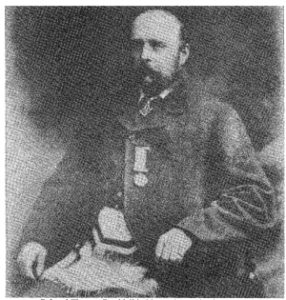
Colonel Braddell
Brabazon Earl of Meath
From a fantastical beginning amongst the pivotal battle of Saxon and Norman, the line of Jacques le Barbancon has continued to the present day. After several centuries of steady growth in Surrey and Leicestershire, the family fortunes blossomed when Henry VIII dispatched the Machiavellian Sir William Brabazon to Ireland as Vice-Treasurer. He established the family at Kilruddery and his grandson was created 1st Earl of Meath in 1627. Over the next three hundred years, the family consolidated its influence in Wicklow, Ireland and the wider world of the British Empire. A strong sense of philanthropy, evident since the establishment of the Meath Hospital in the 1750s, became the guiding force of the 12th Earl and his Countess during the reigns of Queen Victoria and Edward VII. The father and grandfather of the present Earl were distinguished war heroes and this close knit Wicklow family continues to generate characters of great charm and generosity.
Click HERE for more information.

The Countess of Meath
Boyse of Bannow
The 19th century Boyses were the epitome of what good landlords should be. Samuel Boyse and his son Thomas built a magnificent house, Bannow House, on the 4,500 acre estate and laid out the beautiful four acres of gardens looking out over the sea towards the islands off the coast. In the process an army of local tradesmen and labourers were employed, not alone on the house building but on land drainage, road building and cultivation. Twelve miles of road were laid down by the men who received a wage of 10p per day. The materials and wages were paid for by the Boyse family. For their part in the land reclamation each workman received some acres of the reclaimed land at very low rent. The Boyse family also gave £1000 towards the building of a new parish church and Miss Boyse donated a fine stained glass window as a back drop to the main altar.
Click HERE for more information.

Boyd of Wexford & Kilkenny
According to family tradition the Boyds were a junior branch of the Royal family of Stuart of Scotland and got their name from the Gaelic word Buidhe meaning yellow haired, to distinguish their sept.
Lord Kilmarnock, whose son, Sir Thomas Boyd, married the Lady Mary, a sister of King James III, had two other sons Archibald and Alexander. The Wexford Boyds descended from Alexander through his son John. John’s grandson, was Sir John Boyd 1st Baronet of Danson Hill, Kent. Sir John’s third son, James, was James Boyd the founder of the Wexford/Kilkenny Boyd family. Thereafter the names James and John appear with astounding regularity in the different generations of the Boyds.
Click HERE for more information.

Boxwell of Wexford
According to Burkes Irish Family Records, John Boxwell, of Wooton Bassett, Wiltshire, was the founder of the Wexford dynasty. Helen Skrine of Butlerstown House, a daughter of Francis Boxwell, the last Boxwell occupier of Butlerstown, told an interesting story about the origins of the Boxwell family. The founding ancestor, John, was a private secretary to Queen Mary, the older sister of Queen Elizabeth, and for his services he ‘has granted an estate in Wiltshire called Littlepark. His descendant John Boxwell, backed the wrong side in the Civil War in England and was accused of harbouring royalists. He was charged with supplying them with 480 lbs. of cheese and 30 head of cattle! His estate was confiscated and his son was forced to remove into Ireland . He came to Dublin and took the Oath of Allegiance and Supremacy, thus becoming a Freeman of Ireland.
He went to Wexford town where he became a ship’s chandler, and a dealer in rabbit skins and became successful as a merchant.
Click HERE for more information.

Bolton of Bective Abbey
Sir Richard Bolton, Knight (c.1570-1648), was the son of John Bolton of Great Fenton in Staffordshire, and, depending on the source, the family’s origins are believed to have been in either Lancashire or Westmorland.[1] Concluding that the origins of the name are toponymic the family have claimed descent from Ughtred de Bolton whose 12th century effigy adorns the church at Bolton in Westmorland.[2] Richard Bolton commenced his career as a lawyer. However his beginnings, practising as a barrister, seem to have been marred by an encounter with the notorious, Westminster based, Court of Star Chamber. The threat of reproach from that sinister body appears to have influenced his remove to Ireland. In Dublin he first emerges as a recorder of the city in about 1606/7 and the following year he had sufficiently ingratiated himself to earn a commendation from the Lord Deputy, Sir Arthur Chichester.
[1] The most comprehensive account of Bolton’s career, from which the following is derived, appears to be the entry written by Sir John T. Gilbert for the Dictionary of National Biography, hereafter DNB (L. Stephen and S. Lee, eds. Vol. II, 1905, pp. 790-792).
[2] Charles Knowles Bolton, Bolton Families in Ireland (with their English and American kindred). 1937.
Click HERE for more information.

Bolton of Co. Meath
Sir Richard Bolton, Knight (c.1570-1648), was the son of John Bolton of Great Fenton in Staffordshire, and, depending on the source, the family’s origins are believed to have been in either Lancashire or Westmorland.[1] Concluding that the origins of the name are toponymic the family have claimed descent from Ughtred de Bolton whose 12th century effigy adorns the church at Bolton in Westmorland.[2] Richard Bolton commenced his career as a lawyer. However his beginnings, practising as a barrister, seem to have been marred by an encounter with the notorious, Westminster based, Court of Star Chamber. The threat of reproach from that sinister body appears to have influenced his remove to Ireland. In Dublin he first emerges as a recorder of the city in about 1606/7 and the following year he had sufficiently ingratiated himself to earn a commendation from the Lord Deputy, Sir Arthur Chichester.
[1] The most comprehensive account of Bolton’s career, from which the following is derived, appears to be the entry written by Sir John T. Gilbert for the Dictionary of National Biography, hereafter DNB (L. Stephen and S. Lee, eds. Vol. II, 1905, pp. 790-792).
[2] Charles Knowles Bolton, Bolton Families in Ireland (with their English and American kindred). 1937.
For More Info Click Here
Blunden of Kilkenny
The first Blunden in Ireland may in fact have been Overington who is described as one of the Cromwellian ‘adventurers’ in an article in Kilkenny History and Society. Overington was granted the lands in lieu of the money he had adventured. He was originally from Southwark in Surrey and was by profession a whitster or cloth bleacher…
Click HERE to purchase the Kindle version

Bligh of Co. Meath
Ivo Bligh the 8th Earl of Darnley, who succeeded his brother Edward (the 7th Earl), is best known as the English cricketer who was responsible for ‘The Ashes’. Apparently the story goes that following an unexpected defeat of the English team by the Australians at the Oval, in 1882, a journalist wit wrote an obituary on ‘the Death of English Cricket’ and that all that was left was “The Ashes” The following year Ivo led a team to Australia to win back the laurels lost at the Oval. While there they stayed with the wealthy Clarke family and during their stay played a fun game against the Clarke Eleven. After the match the fun loving ladies of the Clarke household presented Ivo with an urn holding the ashes of either the ball or the bails used in the match. Ivo’s eleven were very successful in Australia and they returned home as heroes of the hour, bringing with them ‘The Ashes’. The ‘trophy’ was kept in Cobham Hall until 1929 when it was presented to the M.C.C. by Ivo’s widow.
Prior to his death in 1817 William Bligh of Mutiny on the Bounty fame made a will in which he named his relative, John Bligh, the Earl of Darnley, as one of his two executors.
Click HERE to purchase the book.

Blacker of Woodbrook
The Blacker home at Woodbrook which was built in the late 18th century has one of the most impressive staircases ever seen. It is described by Culleton in his ‘Treasures of the Landscape’: “ the unique staircase is a most beautiful unsupported curve, so sprung that a cat walking on it makes it vibrate.’ To quote Timothy Riordan “Woodbrook is a deceptively vast block of a house and its beauty lies in its perfect proportions and haunting setting high on the Blackstairs mountains. The staircase or flying spiral is a tour de force of the joinery art, unique it is believed in Ireland and possibly in Europe. In the halcyon days at Woodbrook before 1914 the great aunts used to whoosh down the bannisters being caught by the Butler at the bottom. The last Blacker who tried that in the 1960s fell and broke his arm!”
The house may have been built by the Ven. Arthur Jacob for his daughter Susan who married William Blacker. Woodbrook House itself was a model period home and boasted dimensions in keeping with the importance of the occupants. The windows were another special feature, built in the Wyatt
style and the Gardens which were formal and spectacular were laid out to the front and rear of the main house.
Click HERE to purchase the print version of the book.


